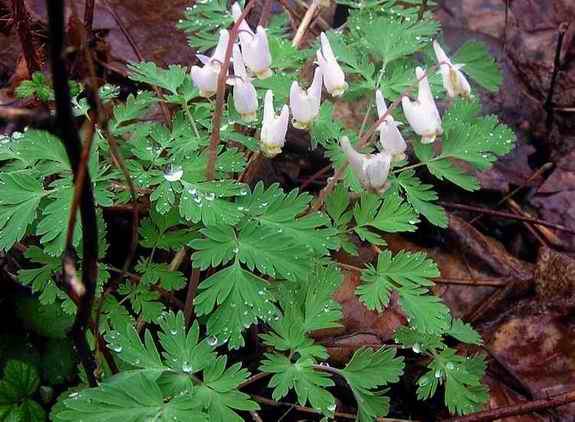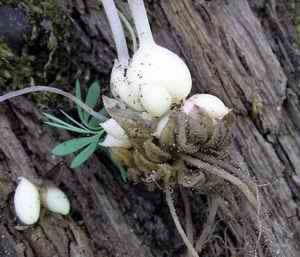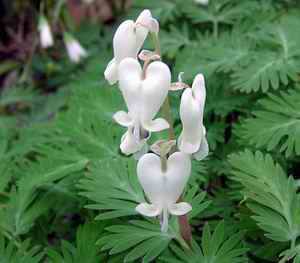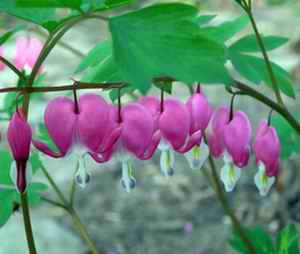|
Return to Hiker's Notebook Home Page
Common Name: Dutchman's Breeches, Staggerweed, Blue
staggers, Soldier cap, Fairy candles, Eardrops, Monk's head, Butterfly
banners, Bachelor's breeches, Little boys' breeches - The various references
to types of breeches refer to the shape of the flower that has the appearance
of a pair of baggy pantaloons that are inverted (above). Squirrel Corn, Turkey pea, White heart, Bleeding heart, Colicweed, Ghost corn, Indian potato, Wild hyacinth - The root structure consists of yellow nodules that look like kernels of corn, often eaten by squirrels (right).
Scientific Name: Dicentra cucullaria - The generic name is from the Greek kentron, meaning point with the prefix di- signifying two, referring to the two points or spurs of the flowers (the legs of the breeches). The species name is from the Latin cucullus, which means a hood or cowl, the shape of the flower; cucullate means shaped like a hood. The Squirrel corn species is D. canadensis, a Latinized form of "from Canada."
Members of the Dicentra genus contain isoquinolines, which are associated with the quinolines in coal tar and serve as the parent structure of many alkaloids; of particular interest are aporphine, from which morphine is derived, and protopine, which is found in opium poppies. These alkaloids impart toxicity to the plants that are manifested as depressants to the central nervous system; symptoms range from tremors and labored breathing to paralysis and death. Grazing animals such as cattle and horses that consume the leaves are stricken initially by a staggering gait that can degenerate into frothing of the mouth, vomiting, and convulsions. The common names Staggerweed, Colicweed and Blue staggers are mnemonics for the rancher to restrict grazing animals from areas where members of the Dicentra genus would be likely to grow. Exposure to the plants can result in contact dermatitis can result in some people.
As is the case with many wild plants, toxic alkaloids can be used effectively as medication if taken in moderation. Native Americans applied a poultice made from the leaves of Dutchman's breeches to treat skin disorders and used the roots to make a tea that was both diuretic (inducing urination) and sweat-inducing (to rid the body of onerous vapors). The Haudenosaunee Indians (more commonly known as the Iroquois) used a liniment made from the leaves to apply to the legs of small children to strengthen their leg muscles for running. It is not known if they initiated this practice due to the fact that the bifurcated flowers looked like two legs, as would be the case if the Doctrine of Signatures was applied.
Squirrel corn and Dutchman's breeches were among the favored medications of a group known as the eclectic practitioners that achieved some prominence for their pharmacy in the 19th Century. They employed "simple and compound syrups, tinctures, acetates, juices of plants both fresh and dried," and introduced the use of several important indigenous herbal remedies, such as alkaloids, into the American pharmacopoeia. In the book King's American Dispensary, Dr. John King proffers that "in all syphilitic affections, it (D. canadensis) is an excellent tonic and alternative; and will likewise be found valuable in scrofula." Traditional physicians, though predominantly critical of the mostly fallacious alkaloid products, promoted the efficacy of the Dicentra genus. In The Physiomedical Dispensatory, Dr. William Cook noted that "it stimulates the salivary glands, fauces (throat or gullet), and stomach; and gives a feeling of warmth and excitement to the stomach and the whole system ... and is among the most valuable agents of its class for secondary syphilis, where it is most generally prized; and is an excellent combining agent to give intensity to relaxants in the treatment of scrofula and scrofulous ulcers, white swellings, herpetic eruptions, and chronic rheumatism." His conclusion that it "leaves behind a good tonic influence" lends credence to the use of Dicentra plant extracts as tonic elixirs.
Dutchman's breeches plants have a symbiotic relationship with insects in two
very important aspects of reproduction that contribute to their success as
ephemeral wild flowers: pollination and seed dispersal. For dioecious species,
fertilization depends on the movement of pollen from the stamen of one plant
to the pistil of another. Because of the deep recesses of the Dutchman's
breeches blossom compared to other flowers, it is nearly impossible for most
pollinators to reach the nectar. However, the proboscises of bumblebees are
of sufficient length; in collecting the nectar, they are the primary
pollinator of D. cucullaria. Other insects including the smaller
honeybees must penetrate the bottom of the flower, creating a hole from which
to extract the nectar. The flowers pollinated by the bumblebees produce seeds
that require dispersal for subsequent germination. This is accomplished by
ants, a process called myrmecochory. Like the
trillium, the seeds of Dutchman's breeches contain elaisome, a fatty
substance that is one of the favorite foods of ants. The seeds are taken to
the ant nest where the elaisomes are consumed; the seed left to ge
The most familiar flower of the Dicentra genus is the bleeding heart (D. eximia), having bright pink heart-shaped blossoms. Indigenous to Asia, it was imported to Great Britain in 1847 where it was a huge success, its unique flowers gracing English gardens. It was brought to North America by early colonists, who dispersed it along their path as they gradually migrated west. A more striking variant of the bleeding heart is the cultivar D. spectabilis (right) that is an Asian species frequently found in domestic gardens.
|


 Though
Dutchman's breeches and Squirrel corn are very similar, they can be readily
distinguished by the shape of the flowers, the latter having more the shape of
a white heart than the elongated shape of leggings (left). The common name
white heart is apt. It is perhaps because of this that D. canadensis
was of great importance to the Menomini Indians as a love charm. A young man
would either throw the flowers at his intended or, alternatively, chew the
roots of the plant. His breath, thus perfumed, was expelled as he circled his
beloved, causing her to follow him anywhere from that time forward.
Though
Dutchman's breeches and Squirrel corn are very similar, they can be readily
distinguished by the shape of the flowers, the latter having more the shape of
a white heart than the elongated shape of leggings (left). The common name
white heart is apt. It is perhaps because of this that D. canadensis
was of great importance to the Menomini Indians as a love charm. A young man
would either throw the flowers at his intended or, alternatively, chew the
roots of the plant. His breath, thus perfumed, was expelled as he circled his
beloved, causing her to follow him anywhere from that time forward.  rminate,
appropriately buried in rich, aerated soil.
rminate,
appropriately buried in rich, aerated soil.